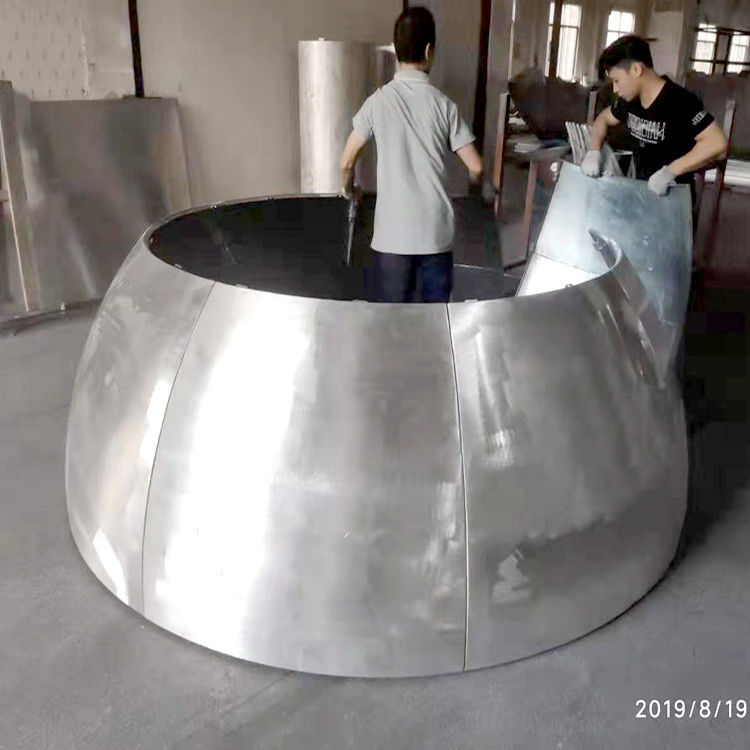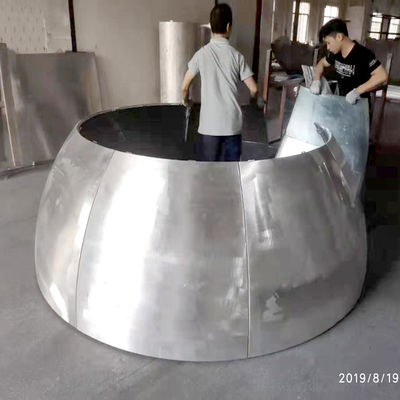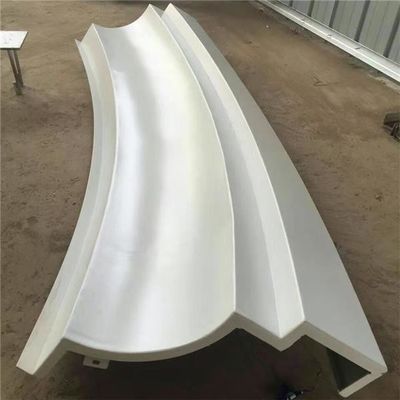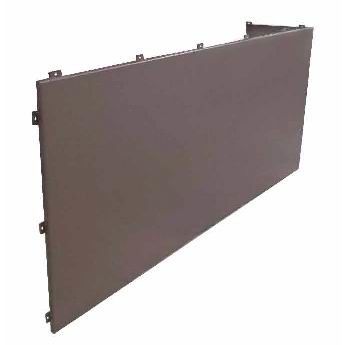
|
|
| Brand Name: | RENOXBELL |
| Model Number: | CLADDING-006 |
| MOQ: | 100 square meters |
| Price: | USD50 to USD200 per square meter |
| Packaging Details: | plywood crates |
| Payment Terms: | T/T, L/C, Western Union |
Aluminium Panels with Curved or Hyperbolic Designs for Decorating Building Facades
Key Word about Aluminum Cladding Panels
aluminum curtain wall cladding panel, Metal panel, aluminum wall cladding, Aluminum composite panel, wall cladding panel, Perforated aluminum sheet, Wall aluminum cladding, Aluminum Plate, Perforated aluminum panel, Aluminum Panel, Aluminum composite sheet, Aluminum ceiling panel, Aluminum ceiling, aluminum cladding, Aluminum cladding panel, aluminum facade panel, Ceiling panel, Ceiling tile, Aluminum honeycomb composite panel, Aluminum honeycomb panel, Metal cladding panel, Corrugated Aluminum Sheet, aluminum coil, aluminum plate, building material, decoration material, construction material, ACP, Aluminum composite material, ACM, aluminium composite panel, wall cladding, metal wall panel, Aluminum wall panel, aluminium wall panel, exterior wall panels, Aluminum sheet, curtain wall panel, Wall panel, metal wall cladding, Aluminum Wall cladding panel, aluminum curtain wall panel
![]()
Descriptions of Aluminium Panel
Aluminum cladding panels are made from high quality aluminum alloy sheets be cutting, shaping, welding, polishing and spray coating, the popular thickness of the aluminum cladding panels is 1.5mm, 2.0mm, 2.5mm and 3.0mm and sizes can be customized according to the installation frames and customer's drawings and designs. All the aluminum panels are prefabricated for ready installation, no need for any process on site.
Aluminum Plate is a high strength, low weight aluminum alloy sheet that is corrosion-resistant and has excellent formability. Using aluminum is a better solution for an environmentally sustainable future. Aluminum does not rust or corrode, is impervious to termites and pests, and is fire resistant. Great for the fireplaces or BBQ walls. It also requires ZERO maintenance and can handle every climate type. Aluminum is 100% recyclable; that means Aluminum is a forever product. It is so long-lasting that 75% of all aluminum ever created is still in use today! Remarkable. Aluminium panels are cut to fit on-site installation frames, saving time and money.
A well-designed building facade can increase the value of a building significantly. It can also be used to make a building stand out from the surrounding architecture. The design of a facade can either be contemporary or traditional depending on the building's style, and can be accentuated with colors, patterns, and textures. Additionally, certain features may be added to a facade such as balconies, awnings, and canopies to add another layer of design and character to the building.
![]()
What Is Wall Cladding?
Aluminum cladding systems are durable building materials applied to a facade to protect the building from exterior elements. In the construction industry, the term “cladding” means a building covering system that protects the building by offering an extra layer while providing aesthetics. Since architects and building contractors utilize metal cladding systems for current projects, manufacturers are developing modern aluminum cladding systems with high functionality and beautiful finishes. Thanks to modern technologies and development methods, the aluminum panels can last for a long time.
At the most fundamental level, wall cladding is any material used in the construction industry that’s installed on the exterior of a building and serves as part of the building envelope. The wall system provides numerous functions and advantages, from providing thermal insulation and air and moisture resistance, to adding design and aesthetic character to a building’s appearance and structure.
Wall cladding finishes may vary from a material’s natural finish to painted, treated, or physically altered to meet a specific design intent. In recent years however, there’s been a huge shift towards product and finish selection based on factors related to sustainability, building performance, and the safety and wellbeing of its occupants.
Why Use Aluminum Cladding?
Aluminum wall cladding is a material of choice in numerous configurations including single skin sheet, thicker solid aluminum plate, and aluminum composite material (ACM) consisting of two aluminum skins bonded to a solid fire-retardant core. There are a number of reasons why aluminum wall cladding is the preferred choice.
Sustainability. Aluminum is a continuously recycled metal with almost 75% of all the aluminum ever produced still in use today.
Versatility in function. Finished aluminum wall cladding can be formed into various shapes and configurations, and with a natural light weight and high strength to weight ratio, can be installed faster and more economically than heavier wall cladding choices. This enables architects to design buildings that meet their vision while taking advantage of the functional benefits of the material.
When properly designed and installed, aluminum wall cladding, as part of the exterior wall assembly, is an integral part of a building’s weather resistance, preventing unwanted air and water intrusion while providing specific energy performance.
It also contributes to the safety and welfare of a building’s occupants as wall assemblies must comply with fire safety requirements.
Finally, aluminum wall cladding can be finished with a wide range of options from physical texturing, such as embossing or roll-forming sheet, to anodizing, spray coating, and coil coating sheet and plate. The type of finishing employed depends on the needs of the application as well as the limitations of the wall cladding product itself.
For pre-finished aluminum wall cladding, such as single skin sheet, ACM aluminum composite material, and solid aluminum plate, coil coated finishing is the typical application process of choice.
Architects specify coil coated finishes because of their color consistency and durability. When utilizing AAMA 2605 compliant paint coatings such as 70% resin kynar, the material can be backed by industry standard finish warranties spanning 20 or 30 years from installation.
In addition to industry standard solid colors to finishes that are more metallic in appearance, coil coating opens up a plethora of finishes, from solid color, metallic like colors, and specialty finish options that mimic wood, natural metals, and even stone finishes.
The following features and advantages of aluminum cladding panels make the building decoration and facade installation easy, lower costs, less workorce, higher efficiency and more environment-friendly.
![]()
What’s a building facade?
A building facade is the face of a building, it is the exterior of a structure and typically the first part of the building that people see. It is the main visible and aesthetic feature of a building and can have a major influence on a person’s perception of the building. A building facade can be made up of a variety of materials such as stone, brick, concrete, glass, metal panel, and wood, which can all be used to create different textures and styles. The facade also helps to protect the building from the elements, while providing a layer of insulation, soundproofing and other features.
In architectural terms, the facade is the most visible aspect of a building, and can act as a representation of the structure’s purpose and heritage. Often the facade will feature intricate detailing, bold colors and stylish materials, making it a work of art that stands out from the rest of the structure. It is also important to remember that the facade of a building is not just the front face, but all sides of the structure. The side walls, roof and entrance all contribute to the overall look and feel of the building.
The purpose of a building facade is to protect the inside of the building from environmental conditions. It provides a barrier from the elements such as water, wind, and heat, allowing the building to remain efficient and comfortable for its inhabitants. The facade can also act as an insulation system and is important for reducing energy costs. Additionally, it can also add to the overall aesthetics of a building and make the exterior more aesthetically pleasing.
Overall, the building facade is a crucial element of a structure that can both protect and enhance the building. It plays an important role in energy efficiency and influences both the exterior and interior design of a building. Facades are used to make a building stand out, draw attention, and increase its overall value.
![]()
In recent years, technology has revolutionized the design and construction of facades, as new materials and methods are constantly emerging to help create more efficient, attractive and cost-effective buildings. Aluminum and its composite sheets or panels are one type of the most popular materials on the building envelope and decoration market, they are especially widely used for the commercial buildings. The features of aluminum and its composite materials for building wall cladding and decoration include light weight, heat insulation and energy-saving, a variety of customized sizes, shapes, designs and colors, weather resistance and durable service, attractive look, recyclable material.


|




| Brand Name: | RENOXBELL |
| Model Number: | CLADDING-006 |
| MOQ: | 100 square meters |
| Price: | USD50 to USD200 per square meter |
| Packaging Details: | plywood crates |
| Payment Terms: | T/T, L/C, Western Union |
Aluminium Panels with Curved or Hyperbolic Designs for Decorating Building Facades
Key Word about Aluminum Cladding Panels
aluminum curtain wall cladding panel, Metal panel, aluminum wall cladding, Aluminum composite panel, wall cladding panel, Perforated aluminum sheet, Wall aluminum cladding, Aluminum Plate, Perforated aluminum panel, Aluminum Panel, Aluminum composite sheet, Aluminum ceiling panel, Aluminum ceiling, aluminum cladding, Aluminum cladding panel, aluminum facade panel, Ceiling panel, Ceiling tile, Aluminum honeycomb composite panel, Aluminum honeycomb panel, Metal cladding panel, Corrugated Aluminum Sheet, aluminum coil, aluminum plate, building material, decoration material, construction material, ACP, Aluminum composite material, ACM, aluminium composite panel, wall cladding, metal wall panel, Aluminum wall panel, aluminium wall panel, exterior wall panels, Aluminum sheet, curtain wall panel, Wall panel, metal wall cladding, Aluminum Wall cladding panel, aluminum curtain wall panel
![]()
Descriptions of Aluminium Panel
Aluminum cladding panels are made from high quality aluminum alloy sheets be cutting, shaping, welding, polishing and spray coating, the popular thickness of the aluminum cladding panels is 1.5mm, 2.0mm, 2.5mm and 3.0mm and sizes can be customized according to the installation frames and customer's drawings and designs. All the aluminum panels are prefabricated for ready installation, no need for any process on site.
Aluminum Plate is a high strength, low weight aluminum alloy sheet that is corrosion-resistant and has excellent formability. Using aluminum is a better solution for an environmentally sustainable future. Aluminum does not rust or corrode, is impervious to termites and pests, and is fire resistant. Great for the fireplaces or BBQ walls. It also requires ZERO maintenance and can handle every climate type. Aluminum is 100% recyclable; that means Aluminum is a forever product. It is so long-lasting that 75% of all aluminum ever created is still in use today! Remarkable. Aluminium panels are cut to fit on-site installation frames, saving time and money.
A well-designed building facade can increase the value of a building significantly. It can also be used to make a building stand out from the surrounding architecture. The design of a facade can either be contemporary or traditional depending on the building's style, and can be accentuated with colors, patterns, and textures. Additionally, certain features may be added to a facade such as balconies, awnings, and canopies to add another layer of design and character to the building.
![]()
What Is Wall Cladding?
Aluminum cladding systems are durable building materials applied to a facade to protect the building from exterior elements. In the construction industry, the term “cladding” means a building covering system that protects the building by offering an extra layer while providing aesthetics. Since architects and building contractors utilize metal cladding systems for current projects, manufacturers are developing modern aluminum cladding systems with high functionality and beautiful finishes. Thanks to modern technologies and development methods, the aluminum panels can last for a long time.
At the most fundamental level, wall cladding is any material used in the construction industry that’s installed on the exterior of a building and serves as part of the building envelope. The wall system provides numerous functions and advantages, from providing thermal insulation and air and moisture resistance, to adding design and aesthetic character to a building’s appearance and structure.
Wall cladding finishes may vary from a material’s natural finish to painted, treated, or physically altered to meet a specific design intent. In recent years however, there’s been a huge shift towards product and finish selection based on factors related to sustainability, building performance, and the safety and wellbeing of its occupants.
Why Use Aluminum Cladding?
Aluminum wall cladding is a material of choice in numerous configurations including single skin sheet, thicker solid aluminum plate, and aluminum composite material (ACM) consisting of two aluminum skins bonded to a solid fire-retardant core. There are a number of reasons why aluminum wall cladding is the preferred choice.
Sustainability. Aluminum is a continuously recycled metal with almost 75% of all the aluminum ever produced still in use today.
Versatility in function. Finished aluminum wall cladding can be formed into various shapes and configurations, and with a natural light weight and high strength to weight ratio, can be installed faster and more economically than heavier wall cladding choices. This enables architects to design buildings that meet their vision while taking advantage of the functional benefits of the material.
When properly designed and installed, aluminum wall cladding, as part of the exterior wall assembly, is an integral part of a building’s weather resistance, preventing unwanted air and water intrusion while providing specific energy performance.
It also contributes to the safety and welfare of a building’s occupants as wall assemblies must comply with fire safety requirements.
Finally, aluminum wall cladding can be finished with a wide range of options from physical texturing, such as embossing or roll-forming sheet, to anodizing, spray coating, and coil coating sheet and plate. The type of finishing employed depends on the needs of the application as well as the limitations of the wall cladding product itself.
For pre-finished aluminum wall cladding, such as single skin sheet, ACM aluminum composite material, and solid aluminum plate, coil coated finishing is the typical application process of choice.
Architects specify coil coated finishes because of their color consistency and durability. When utilizing AAMA 2605 compliant paint coatings such as 70% resin kynar, the material can be backed by industry standard finish warranties spanning 20 or 30 years from installation.
In addition to industry standard solid colors to finishes that are more metallic in appearance, coil coating opens up a plethora of finishes, from solid color, metallic like colors, and specialty finish options that mimic wood, natural metals, and even stone finishes.
The following features and advantages of aluminum cladding panels make the building decoration and facade installation easy, lower costs, less workorce, higher efficiency and more environment-friendly.
![]()
What’s a building facade?
A building facade is the face of a building, it is the exterior of a structure and typically the first part of the building that people see. It is the main visible and aesthetic feature of a building and can have a major influence on a person’s perception of the building. A building facade can be made up of a variety of materials such as stone, brick, concrete, glass, metal panel, and wood, which can all be used to create different textures and styles. The facade also helps to protect the building from the elements, while providing a layer of insulation, soundproofing and other features.
In architectural terms, the facade is the most visible aspect of a building, and can act as a representation of the structure’s purpose and heritage. Often the facade will feature intricate detailing, bold colors and stylish materials, making it a work of art that stands out from the rest of the structure. It is also important to remember that the facade of a building is not just the front face, but all sides of the structure. The side walls, roof and entrance all contribute to the overall look and feel of the building.
The purpose of a building facade is to protect the inside of the building from environmental conditions. It provides a barrier from the elements such as water, wind, and heat, allowing the building to remain efficient and comfortable for its inhabitants. The facade can also act as an insulation system and is important for reducing energy costs. Additionally, it can also add to the overall aesthetics of a building and make the exterior more aesthetically pleasing.
Overall, the building facade is a crucial element of a structure that can both protect and enhance the building. It plays an important role in energy efficiency and influences both the exterior and interior design of a building. Facades are used to make a building stand out, draw attention, and increase its overall value.
![]()
In recent years, technology has revolutionized the design and construction of facades, as new materials and methods are constantly emerging to help create more efficient, attractive and cost-effective buildings. Aluminum and its composite sheets or panels are one type of the most popular materials on the building envelope and decoration market, they are especially widely used for the commercial buildings. The features of aluminum and its composite materials for building wall cladding and decoration include light weight, heat insulation and energy-saving, a variety of customized sizes, shapes, designs and colors, weather resistance and durable service, attractive look, recyclable material.